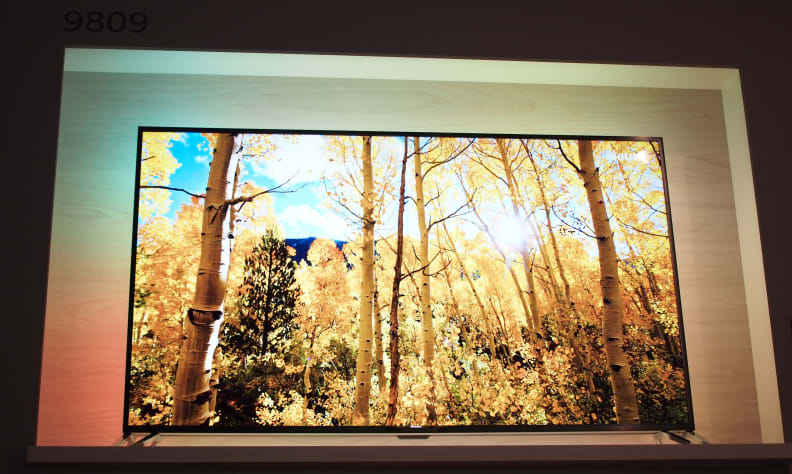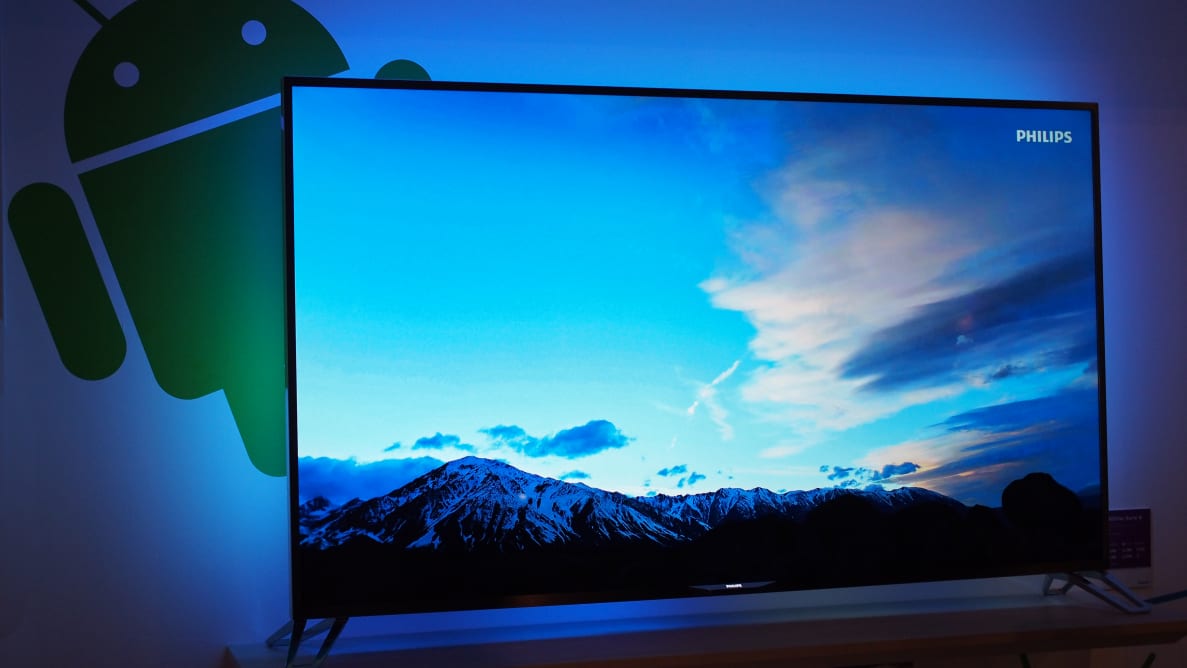Less frequently spotted are full-array UHD TVs, a technology that produces excellent contrast by using independently controllable zones of LEDs. Imagine that rather than a single flashlight illuminating the panel, you have dozens that can each turn on and off. With such a panel, the dark areas can get really dark, while the bright areas can get really bright, without negatively impacting either other. As plasma technology continues to decline, LED LCD TVs need a full array of bulbs if they're going to compete with OLED panels.
One of these rare beauties decorated the Philips booth: the 65-inch PUS9809 UHD LED TV. The model will only be available for European customers, selling later this month for €5,199.
Looks and Experience
Technicolor Android
Powered off, the PUS9809 looks pretty straightforward: Two sets of chromed, Y-shaped feet prop up a simple panel from either side. A slim bezel wraps the frame. It looks like your basic recipe for a flat panel TV, until you turn it on.
Philips' Ambilight is designed to cast a multi-colored glow around your TV with LED lights embedded in the back of the frame. The flashy feature is four-sided, meaning the TV shines in four directions to liven up your living room. The effect certainly won't suit everyone, but if you like a bit of sexy lighting, you may just love this feature.

Full-array LED panels generally mean business, wielding deep black levels, heightened contrast, and excellent screen uniformity.
Of course the more useful headlining attribute is the TV's Android-powered smart platform, which lets the PUS9809 run multiple apps simultaneously. This makes it much faster to hop from live television to web browsing, and back again, for instance. We've seen similar perks on LG's webOS platform this year.
The Google Play store and a host of streaming services are obviously on hand, and there are piles of cool extras. Users get a motion remote with full QWERTY keypad, 3D glasses, and fluid options for playing personal media through the TV. Voice commands come in handy too, and even simple hand motions can be captured by (presumably) a built-in camera, allowing you to alter volume, flip through channels, and so forth. The experience feels quite premium, from top to bottom.
{{ photo_gallery name="TV Design Gallery" }}
The Android-powered TV enables treats like Spotify Connect and Chrome browsing, too. A two-tuner system means you can watch one channel and record another simultaneously.
Picture
Let there be light—but let there be dark, too.
Philips presented its 65-inch PUS9809 full-array display with pride this week, and it's no wonder. Full-array TVs are more expensive to produce than the competing technology, edge-lit LED. Also, edge-lit models can be designed with much thinner bezels, which show better in a side-by-side retail environment.
As such, full-arrays are vastly outnumbered by edge-lit TVs. But the fact is, an LCD backlit with a full array of bulbs gets a liquid crystal display about as close as it can come to plasma-like picture quality.
The 9809's backlit panel is split into 144 independently driven zones, which allows a single point on screen to blaze with brightness while the rest shut off entirely. This is crucial, because great black levels and high contrast are absolute cornerstones of premium image quality.
Meanwhile, the 4K panel is four times sharper than regular HD, and an internal upscaling engine optimizes lower-res signals for near-UHD quality. Although UHD streaming partnerships are missing here, Philips does have a solution in the works: Buyers will get free UHD media players as early as Q1 in 2015 if they also purchase a 9809.
Last Word
When life sticks you with LED TVs, make them full-array.
Plasma stood tall for a long time as the ultimate choice in picture quality, but for better or for worse, its retirement is nigh. That's why it's gratifying to see companies like Philips pouring resources into LED LCD TV tech, resulting in products like the 65PUS9809.
If LCD manufacturers are serious about replacing plasma with a worthy successor, they need to roll out more full-array TVs. This year, Sony, Panasonic, and Vizio are the only known contenders in the U.S. (so far). Philips only has plans to release the 65PUS9809 to the European market, but we hope the brand's commitment to full-array technology will spread throughout the market.
Meet the tester
Virginia is a former Managing Editor at Reviewed.com. She has a background in English and journalism. Away from the office, Virginia passes time with dusty books & house cats.
Checking our work.
Our team is here for one purpose: to help you buy the best stuff and love what you own. Our writers, editors, and lab technicians obsess over the products we cover to make sure you're confident and satisfied. Have a different opinion about something we recommend? Email us and we'll compare notes.
Shoot us an email


